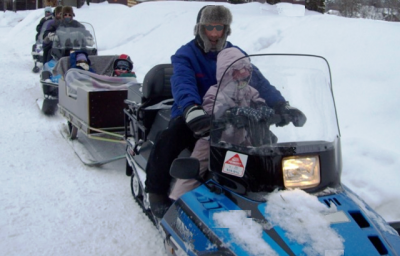I’m listening to the sound of silence. Not unusual in these parts, but unusual on a Saturday morning outside our house next to Adolf Hedinsvägen.
The silence tells me a lot of things. It tells me that it’s a Saturday in the middle of March. It tells me that Kiruna is a society where traditions are strong. It also tells me that most people who live here own a snow scooter – or six.
Whereas most days of the year you would make the short five minute journey out of Kiruna into the landscape to experience silence, this is the day when everything is turned on its head. You want peace and quiet, stay at home this weekend.
About 25 kilometres out of town is an area and a lake called Rautas, the name of the river flowing through it. An area of outstanding beauty, today it will be alive with petrol fumes, the roar of engines, and the hum of hundreds of people looking for fish.
A long traffic jam of snow scooters will be snaking their way along the bumpy snow scooter track from the E10 road out to the Rautas lake, another 20 kilometres or so away from the road. It’s the start of the fishing season in this particular lake, and by tradition, a ‘Kirunabo’ will want to be there at the very beginning, at the very first hour that fishing is allowed. Along with hundreds of others. Just because they always have, and their parents always have.
It’s also, perhaps, for young men of a certain age, an initiation rite, riding for the first time on their very own snow scooter. By law you’re only allowed to do that when you’re 16, and if you have a special licence, though most children have been driving scooters under parental supervision long before that. But as a teenager, at least as a young male, the feeling of having your own snow scooter must feel like the moment of adulthood.
(You see these coming-of-age youngsters wandering around town, baggy trousers fashionably falling to their knees, peaked cap turned rebelliously in the wrong direction. They walk by swinging their legs forward from the hip, leaving a wide gap between. It looks as if they’ve just leapt off a horse, or perhaps the horse has just run away from underneath them and they haven’t noticed. Only in Kiruna it isn’t a horse – it’s a snow scooter.)
However Rautas ‘Premiär’, as it is known, is not just for young men. It’s for young women, for families, for children hunched up on scooters behind their parents. It’s a family event, a journey, a hunt for food, and then a meal – fish cooked over a smoky fire and eaten under the stars – Kiruna’s version of a Thanksgiving dinner.

The journey out to Rautas is no walk in the park. It’s a long uncomfortable ride along a bumpy snow-packed path. When you arrive it’s glorious nature, nothing else. So you need to bring everything with you – a tent, cooking equipment, warm clothing, firewood or gas, and something to eat and drink with the fish, (which you assume you will catch), something to sit on, something to sleep on, something to sleep in… Only this will be no communing with nature because the rest of Kiruna has come with you.
As someone who doesn’t own a snow scooter I’m excluded from this event. I’m not complaining though. If I had a snow scooter I wouldn’t go – travelling to one small area with so many others doesn’t appeal, but mainly it’s because I’ve not grown up with the tradition. I see it as an outsider, and like so many traditions (mine included) it looks strange from where I am. I think of Kiruna rushing, lemming-like, along a river to a lake, the mass following of a primal instinct, to celebrate the First Killing of the Fish.
Viewed from above, the gathering of black-coated scooter riders, tents and campfires must look like some secret satanic ritual. Why this out-of-the-way place? Why so many people? And all for a fish?

